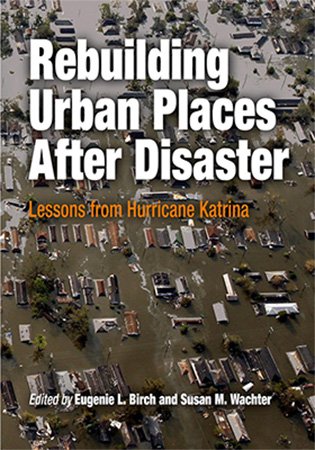
《城市:二十世纪》
这本书探讨了灾后城市及其周边地区的重建,重点讨论了四个主要问题:使城市不易受灾害影响,重建经济活力,应对流离失所者的永久需求,以及重建一种地方感。
自然灾害,如飓风、洪水或地震,以及非自然灾害,如恐怖袭击,是美国在21世纪经历的一部分。为这些活动做准备、承受其影响以及随后重建社区所面临的挑战,需要各级政府与私营部门合作并根据公众意愿做出战略反应。
灾害对城市地区的影响不成比例。从定义上讲,城市及其周边地区对其复杂、相互依存的社会、环境和经济系统造成了巨大破坏。社会和医疗服务崩溃。教育机会和质量方面长期存在的问题变得尤为严重。地方经济停止运转。文化资源消失了。新奥尔良和几个较小的墨西哥湾沿岸城市的困境就是这种现象的例证。
这本书探讨了灾后城市及其周边地区的重建,重点讨论了四个主要问题:使城市不易受灾害影响,重建经济活力,应对流离失所者的永久需求,以及重建一种地方感。要在这些领域取得成功,就需要合作确定优先事项,而这一目标对民主、市场化社会的重建工作构成了重大挑战。谁设定优先事项,如何设定?参与式决策能否在需要有重点的战略选择的条件下组织起来?种族和阶级问题如何与这些优先事项相交?重建的目的是恢复还是改革?撰稿人根据从卡特里娜飓风中吸取的教训,解决了与环境条件、经济需求、社会福利问题以及规划和设计问题相关的这些问题和其他问题。
Rebuilding Urban Places After Disaster: Lessons from Hurricane Katrina
Series: The City in the Twenty-First Century
This volume examines the rebuilding of cities and their environs after a disaster and focuses on four major issues: making cities less vulnerable to disaster, reestablishing economic viability, responding to the permanent needs of the displaced, and recreating a sense of place.
Disasters—natural ones, such as hurricanes, floods, or earthquakes, and unnatural ones such as terrorist attacks—are part of the American experience in the twenty-first century. The challenges of preparing for these events, withstanding their impact, and rebuilding communities afterward require strategic responses from different levels of government in partnership with the private sector and in accordance with the public will.
Disasters have a disproportionate effect on urban places. Dense by definition, cities and their environs suffer great damage to their complex, interdependent social, environmental, and economic systems. Social and medical services collapse. Long-standing problems in educational access and quality become especially acute. Local economies cease to function. Cultural resources disappear. The plight of New Orleans and several smaller Gulf Coast cities exemplifies this phenomenon.
This volume examines the rebuilding of cities and their environs after a disaster and focuses on four major issues: making cities less vulnerable to disaster, reestablishing economic viability, responding to the permanent needs of the displaced, and recreating a sense of place. Success in these areas requires that priorities be set cooperatively, and this goal poses significant challenges for rebuilding efforts in a democratic, market-based society. Who sets priorities and how? Can participatory decision-making be organized under conditions requiring focused, strategic choices? How do issues of race and class intersect with these priorities? Should the purpose of rebuilding be restoration or reformation? Contributors address these and other questions related to environmental conditions, economic imperatives, social welfare concerns, and issues of planning and design in light of the lessons to be drawn from Hurricane Katrina.
OR




